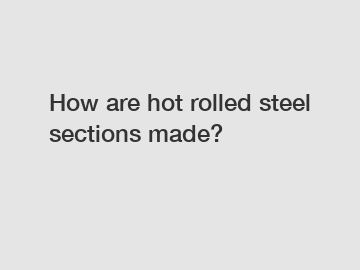Dec. 04, 2023
Minerals
How are hot rolled steel sections made?
Hot rolled steel sections are essential components in various industries due to their versatility, strength, and cost-effectiveness. But have you ever wondered how these sections are made? In this article, we will delve into the manufacturing process of hot rolled steel sections and explore the key points involved.
1. Definition of hot rolled steel sections.

Hot rolled steel sections are manufactured through a process that involves heating billets or slabs above their recrystallization temperature and then shaping them into the desired forms. This process results in steel sections with improved mechanical properties, such as increased strength and ductility.
2. Initial stages: Steelmaking and casting.
The production of hot rolled steel sections begins with steelmaking. Iron ore is smelted in a blast furnace, along with a mixture of limestone and coke, to produce molten iron known as hot metal. This hot metal undergoes further processing to remove impurities and adjust its composition.
Once the desired steel grade is achieved, the molten steel is cast into large rectangular blocks called slabs. Slabs generally have a thickness of around 200mm and serve as the starting material for hot rolled steel sections.
3. Heating and reheating.
The slabs are heated in a furnace to a temperature above their recrystallization point, typically between 1100°C and 1250°C. This high temperature ensures that the material is malleable and can be easily shaped. The heating process also homogenizes the microstructure of the steel, reducing internal stresses and improving its overall properties.
4. Rolling process.
Once the slabs reach the desired temperature, they are passed through a series of rolling mills. These mills consist of carefully placed rollers that progressively shape the heated slabs into the desired sections. The rolling process involves both reducing the thickness and adjusting the shape of the slab.
5. Shaping and cooling.
During the rolling process, the slabs can be shaped into a variety of steel sections, including beams, channels, angles, and rails. The rollers exert significant pressure on the slabs, causing them to deform and adopt the desired cross-sectional shape.
After shaping, the hot rolled steel sections are rapidly cooled to room temperature using water sprays or air jets. This cooling process, known as quenching, helps to lock in the desired properties and prevent the sections from warping or deforming.
6. Finishing operations.
Once the sections have cooled, they undergo various finishing operations. These include cutting them into desired lengths, straightening any potential deformations, and inspecting for any surface defects.
7. Uses and benefits.
Hot rolled steel sections find applications in a wide range of industries, including construction, infrastructure, automotive, and manufacturing. Their versatility allows for easy integration into various structures, providing efficient load-bearing capabilities. Moreover, their cost-effectiveness and durability make them a preferred choice for many projects.
Conclusion.
Hot rolled steel sections play a crucial role in numerous industries, and understanding their manufacturing process provides valuable insights. From the initial stages of steelmaking and casting to the final finishing operations, each step contributes to the production of high-quality sections. By harnessing the strength and versatility of hot rolled steel sections, industries can continue to create durable and efficient structures that meet their specific needs. So, the next time you encounter a steel structure, you'll have a deeper appreciation for the intricate process that goes into creating its components.
If you are looking for more details, kindly visit color steel coil, hot rolled carbon steel coil, painted steel plate.
If you are interested in sending in a Guest Blogger Submission,welcome to write for us!
All Comments ( 0 )